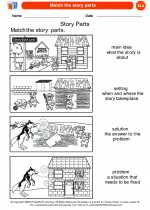Story Parts
Every story is made up of different parts that help to create a complete and engaging narrative. Understanding the different story parts is important for comprehending and analyzing stories.
Characters
Characters are the people, animals, or creatures in a story. They drive the plot and engage readers through their actions and dialogue. Characters can be protagonists (main characters) or antagonists (characters in conflict with the main character).
Setting
The setting of a story is where and when it takes place. It includes the time period, location, and environment. The setting can greatly impact the mood and tone of the story.
Plot
The plot is the sequence of events that make up the story. It includes the exposition (introduction), rising action, climax, falling action, and resolution. The plot is what keeps readers engaged and interested in the story's outcome.
Conflict
Conflict is the struggle or problem that drives the plot. There are different types of conflict, including internal (within a character), external (between characters or with outside forces), and man vs. self, man vs. man, man vs. nature, and man vs. society.
Theme
The theme is the central idea or message of the story. It is the underlying meaning or lesson that the author wants readers to take away from the story. Themes can be universal and apply to real-life situations.
Point of View
Point of view is the perspective from which the story is told. It can be first person (I, we), second person (you), or third person (he, she, they). The point of view affects how readers experience and interpret the events of the story.
Study Guide
- Define the term "characters" and provide examples of different types of characters in stories.
- Identify the setting of a familiar story and explain how it impacts the events and mood of the story.
- Describe the plot of a story by identifying the exposition, rising action, climax, falling action, and resolution.
- Identify the main conflict in a story and explain its significance in driving the plot forward.
- Identify the theme of a story and explain how it relates to real-life experiences and situations.
- Identify the point of view of a story and explain how it influences the reader's understanding of the events.
Understanding these story parts will help you become a more insightful reader and writer, capable of analyzing and appreciating the complexities of different narratives.
.

